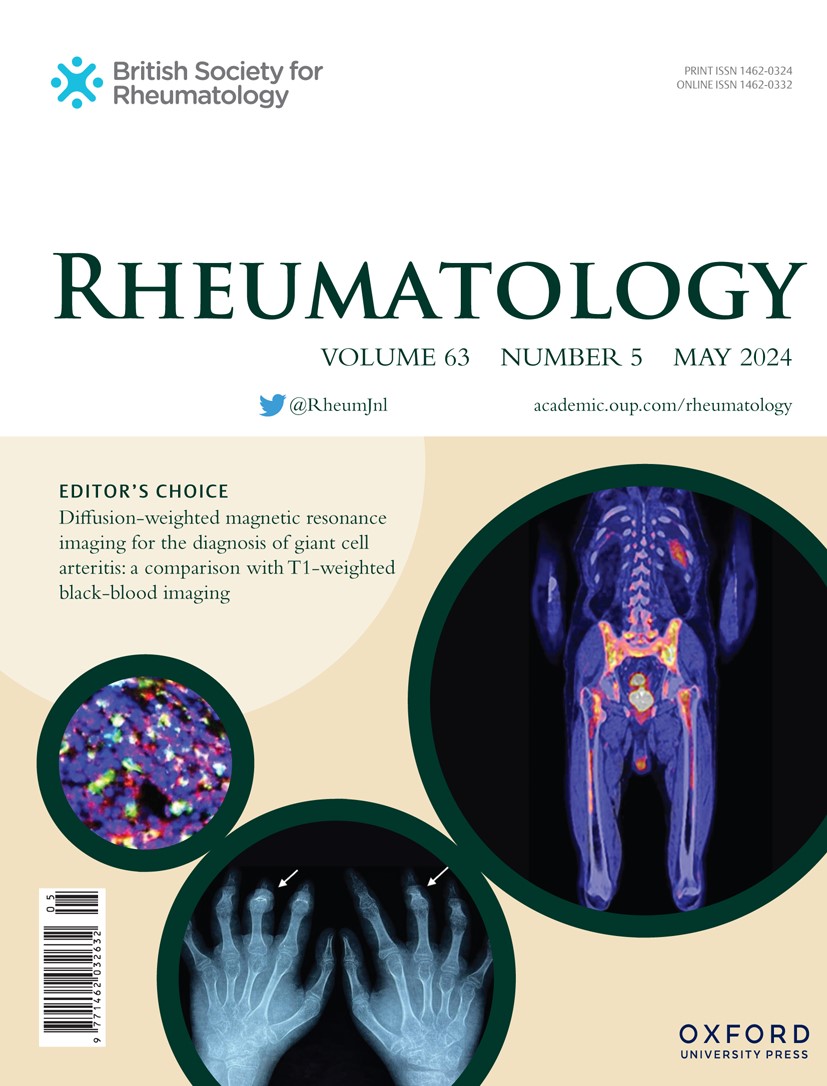P175 Baseline characteristics and efficacy in patients with radiographic axSpA stratified by CRP level: an analysis from the ixekizumab Phase III trial
IF 4.7
2区 医学
Q1 RHEUMATOLOGY
引用次数: 0
Abstract
Background/Aims Elevated baseline (BL) C-reactive protein (CRP) level can serve as a predictor for treatment response to TNF inhibitors in patients (pts) with radiographic axSpA (r-axSpA). The impact of CRP on b/tsDMARD response in r-axSpA is listed as a topic of interest on the ASAS-EULAR research agenda. Ixekizumab (IXE) has previously demonstrated efficacy in the treatment of r-axSpA in pts with normal and elevated CRP. This analysis further investigates the impact of baseline CRP levels on the ASAS40 individual components, BASDAI, and Axial Spondyloarthritis Disease Activity Score (ASDAS). Methods Biologic-naive adults with r-axSpA were enrolled in the COAST-V study (NCT02696785). At BL, pts were randomised to treatment with IXE Q4W, adalimumab (ADA), or placebo (PBO). Randomisation was stratified by baseline (BL) CRP normal (CRP ≤5 mg/L) or elevated (CRP>5 mg/L). This analysis reports change from BL (CFB) at 16 weeks for ASAS40 individual components, BASDAI, and ASDAS responses. Descriptive results for these outcomes are presented according to CRP levels. Results The mean ages of pts with normal CRP at BL were 43.3, 43.7, and 44.8 years for IXE, ADA, and PBO respectively (subsequently reported in that order, herein), whereas the mean age of pts with elevated CRP at BL was 39.6, 40.3, and 41.7 years. Gender, HLA-B27 positivity distribution and the mean duration of axSpA diagnosis was similar across both CRP groups. Pts with normal CRP had lower mean MRI-SPARCC spine score vs those with elevated CRP (6.8, 6.6, and 6.4 vs 15.8, 24.0, and 15.1 units) for IXE, ADA, and PBO respectively. At BL disease activity was comparable between pts with normal and elevated CRP. In pts treated with IXE, ASAS40 response at week 16 was driven by all 4 individual components with the largest improvements seen in morning stiffness (mean of intensity and duration of morning stiffness questions of BASDAI) and spinal pain, across both normal and elevated CRP. BASDAI 50 was achieved by 34.6%, 24.3%, and 15.4% of pts with normal CRP and by 48.1%, 39.2%, and 18.3% of pts with elevated CRP. ASDAS major improvement was achieved by 19.2% (IXE), 8.1% (ADA) and 3.8% (PBO) of pts with normal CRP and by 36.5%, 35,3% and 5.2% of pts with elevated CRP, respectively. Conclusion In pts with r-axSpA, BL clinical characteristics were similar in the normal and elevated CRP groups with pts experiencing similar disease burden. Across IXE and ADA treatment groups, the elevated CRP group tended to achieve higher treatment responses than the normal CRP group. Whereas in patients with normal CRP, CFB of ASAS individual components, BASDAI and ASDAS improvement was numerically highest in IXE Q4W followed by ADA and PBO. Disclosure R. Sengupta: Consultancies; AbbVie, Celgene, Eli Lilly and Company, Novartis, Pfizer, and UCB Pharma. Grants/research support; AbbVie, Celgene, Eli Lilly and Company, Novartis, Pfizer, and UCB Pharma. P.M. Machado: Consultancies; AbbVie, Bristol Myers Squibb, Celgene, Eli Lilly and Company, Janssen, Merck Sharp & Dohme, Novartis, Orphazyme, Pfizer, Roche, and UCB Pharma. P. Goupille: Consultancies; AbbVie, Biogaran, Bristol Myers Squibb, Celgene, Eli Lilly and Company, Janssen, Merck Sharp & Dohme, Novartis, Pfizer, and UCB Pharma. V. Navarro Compán: Consultancies; AbbVie, Eli Lilly and Company, Janssen, Novartis, Pfizer, and UCB Pharma. Grants/research support; ASAS and Novartis. X. Huji: None. M. Sheesh: Corporate appointments; Eli Lilly and Company. Shareholder/stock ownership; Eli Lilly and Company. K. Ng: Corporate appointments; Eli Lilly and Company. Shareholder/stock ownership; Eli Lilly and Company. M. Ngantcha: Corporate appointments; Eli Lilly and Company. Shareholder/stock ownership; Eli Lilly and Company. H. Russ: Corporate appointments; Eli Lilly and Company. Shareholder/stock ownership; Eli Lilly and Company. G. Doridot: Corporate appointments; Eli Lilly and Company. Shareholder/stock ownership; Eli Lilly and Company. X. Baraliakos: Consultancies; AbbVie, Bristol Myers Squibb, Celgene, Janssen, Merck Sharp & Dohme, Novartis, Pfizer, Roche, and UCB Pharma. Grants/research support; AbbVie, Bristol Myers Squibb, Celgene, Janssen, Merck Sharp & Dohme, Novartis, Pfizer, Roche, and UCB Pharma.根据CRP水平分层的x线axSpA患者的基线特征和疗效:来自ixekizumab III期试验的分析
背景/目的基线(BL) c反应蛋白(CRP)水平升高可作为放射学axSpA (r-axSpA)患者对TNF抑制剂治疗反应的预测因子。CRP对r-axSpA患者b/tsDMARD反应的影响被列为asa - eular研究议程中感兴趣的主题。Ixekizumab (IXE)先前已证明对CRP正常和升高的患者治疗r-axSpA有效。该分析进一步研究了基线CRP水平对ASAS40个体成分、BASDAI和轴性脊柱炎疾病活动评分(ASDAS)的影响。方法纳入COAST-V研究(NCT02696785)。在BL时,患者被随机分配到IXE Q4W、阿达木单抗(ADA)或安慰剂(PBO)治疗。随机分组按基线(BL) CRP正常(CRP≤5mg /L)或升高(CRP≤5mg /L)分层。该分析报告了16周时ASAS40单个成分、BASDAI和ASDAS反应的BL (CFB)变化。这些结果的描述性结果根据CRP水平呈现。结果:IXE、ADA和PBO患者的平均年龄分别为43.3岁、43.7岁和44.8岁(本文随后依次报道),而CRP升高患者的平均年龄分别为39.6岁、40.3岁和41.7岁。两组患者的性别、HLA-B27阳性分布和axSpA诊断的平均持续时间相似。在IXE、ADA和PBO中,CRP正常的患者的MRI-SPARCC脊柱平均评分低于CRP升高的患者(分别为6.8、6.6、6.4和15.8、24.0、15.1单位)。正常和CRP升高的患者的BL疾病活动性具有可比性。在接受IXE治疗的患者中,第16周ASAS40反应是由所有4个单独成分驱动的,在正常和升高的CRP中,晨僵(BASDAI晨僵问题的平均强度和持续时间)和脊柱疼痛的改善最大。正常CRP患者达到BASDAI 50的比例分别为34.6%、24.3%和15.4%,CRP升高患者达到BASDAI 50的比例分别为48.1%、39.2%和18.3%。正常CRP患者的ASDAS主要改善分别为19.2% (IXE)、8.1% (ADA)和3.8% (PBO), CRP升高患者的ASDAS主要改善分别为36.5%、35.5%、3%和5.2%。结论在r-axSpA患者中,正常组和CRP升高组的BL临床特征相似,且患者有相似的疾病负担。在IXE和ADA治疗组中,CRP升高组往往比CRP正常组获得更高的治疗反应。而在CRP正常的患者中,在IXE Q4W中,ASAS单项成分的CFB、BASDAI和ASDAS改善的数值最高,其次是ADA和PBO。R. Sengupta:咨询公司;艾伯维、新基、礼来、诺华、辉瑞和UCB制药公司。授予/研究支持;艾伯维、新基、礼来、诺华、辉瑞和UCB制药公司。下午。马查多:咨询公司;艾伯维、百时美施贵宝、新基、礼来、杨森、默克夏普;Dohme, Novartis, orpzyme, Pfizer, Roche和UCB Pharma。P. Goupille:咨询公司;AbbVie、Biogaran、Bristol Myers Squibb、Celgene、Eli Lilly and Company、Janssen、Merck Sharp &;Dohme, Novartis, Pfizer和UCB Pharma。V. Navarro Compán:咨询公司;艾伯维、礼来、杨森、诺华、辉瑞和UCB制药公司。授予/研究支持;asa和诺华。X. Huji:没有。谢伊什:公司任命;礼来公司。股东/股权;礼来公司。吴国强:公司委任;礼来公司。股东/股权;礼来公司。M. Ngantcha:公司任命;礼来公司。股东/股权;礼来公司。H. Russ:公司任命;礼来公司。股东/股权;礼来公司。G. Doridot:公司任命;礼来公司。股东/股权;礼来公司。X. Baraliakos:咨询;艾伯维、百时美施贵宝、新基、杨森、默克夏普;多美、诺华、辉瑞、罗氏和UCB制药。授予/研究支持;艾伯维、百时美施贵宝、新基、杨森、默克夏普;多美、诺华、辉瑞、罗氏和UCB制药。
本文章由计算机程序翻译,如有差异,请以英文原文为准。
求助全文
约1分钟内获得全文
求助全文
来源期刊

Rheumatology
医学-风湿病学
CiteScore
9.40
自引率
7.30%
发文量
1091
审稿时长
2 months
期刊介绍:
Rheumatology strives to support research and discovery by publishing the highest quality original scientific papers with a focus on basic, clinical and translational research. The journal’s subject areas cover a wide range of paediatric and adult rheumatological conditions from an international perspective. It is an official journal of the British Society for Rheumatology, published by Oxford University Press.
Rheumatology publishes original articles, reviews, editorials, guidelines, concise reports, meta-analyses, original case reports, clinical vignettes, letters and matters arising from published material. The journal takes pride in serving the global rheumatology community, with a focus on high societal impact in the form of podcasts, videos and extended social media presence, and utilizing metrics such as Altmetric. Keep up to date by following the journal on Twitter @RheumJnl.
 求助内容:
求助内容: 应助结果提醒方式:
应助结果提醒方式:


